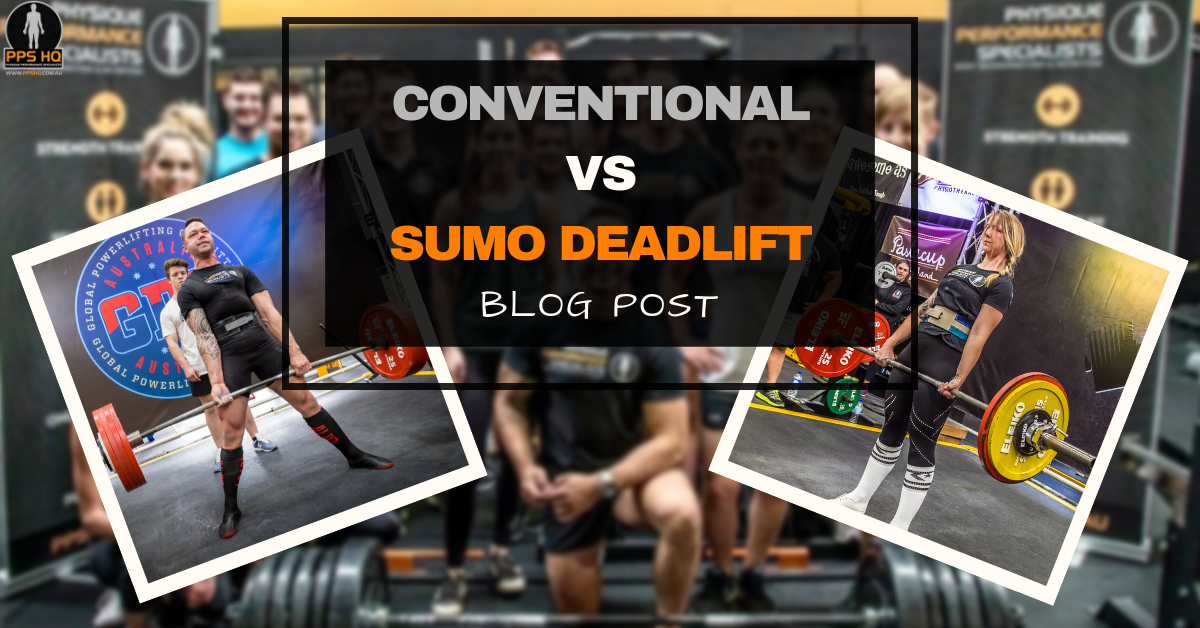There’s been a sudden rise of wide stance or Sumo Deadlift in recent times.
This can probably be attributed to the rise of Powerlifting within the general public, as it’s very common for Powerlifters to be seen pulling Sumo in their meets.
But as a general lifter or your average gym goer, should you be pulling Sumo too?
Are you pulling Sumo just to follow the trend and be like your favourite Instagram athletes, or do you have a valid reason to be?
Because of the increased popularity of the Sumo Deadlift, we have found a lot of people are pulling this style, without knowing what the benefits (or drawbacks) may be and without understanding why they should be.
At Physique Performance Specialists we do have some clients or coaches pulling Sumo over Conventional as; it simply helps you move more weight from A to B in a shorter ROM, while generally putting less stress on your lower-back than the Conventional stance.
But we are very selective about this and also feel very strongly, that everyone should have built up a solid foundation of Conventional pulling before deciding to move to Sumo.
Where as it is common for a lot of people to simply choose Sumo over Conventional because they struggle with a Conventional stance, and instead of solving the deeper issue at hand, they choose to place a band-aid over it by going with the Sumo stance
Let’s look at the pro’s and con’s of each lift and let you decide which one you are best suited to:
Conventional Deadlift
Target muscles:
Hamstrings
Glutes
Lower-back
Lat’s and upper-back
Pro’s:
Works the entire posterior chain which is commonly weak on most individuals
Provides huge functional benefits by teaching the ‘Hinge’ which is a very important movement pattern to learn
Will build more overall strength throughout the body than Sumo
Con’s:
Provides a lot more direct risk to the lower-back than Sumo,
Requires a decent amount of Thoracic (Upper-back) and Hamstring mobility, which does lack in most of the general population,
So your Conventional Deadlift is a full body exercise, but targets more specifically the posterior chain. It’s the perfect example of the ‘Hinge’ movement pattern (where the hips, shoulders and ears move in a line together) and is to us, the king of all compound movements in the gym.
However it can be blamed for many lower-back injuries, which are generally caused by those whom perform the movement without sufficient thoracic or hamstring mobility.
Sumo Deadlift
Target muscles:
Adductors
Glutes
Lats and upper-back
Pro’s:
Has a shorter ROM than your Conventional stance,
Put’s less stress on the lower-back as you require less thoracic mobility,
Typically allows you shift more weight from A -> B.
Con’s:
Works less muscle groups than Conventional ,
Can be very stressful on your groin, adductors and hips due to the wider stance,
You risk being called a cheater by die hard traditionalists (nobody likes that!).
So the Sumo Deadlift generally takes the hamstrings out of the equation and targets more of the adductors and groin. When performing Sumo, your torso is in a more upright position. So it requires less thoracic mobility. This all means there’s a lot less stress put on the lower-back, so it is a good option for those of you with shorter limbs or tight shoulders/lats.
Homer loved a good 'Hinge'
However, this stance requires good hip mobility and can put a lot of stress on the groin. It also provides less overall strength and functional benefits than Conventional.
So as you can see both stances have their pro’s and con’s. But in our opinion every lifter should learn how to perform the Conventional stance comfortably, as the ‘Hinge’ is one of the most important movement patterns to learn in the gym.
Those who don’t suit Sumo better, whether it be due to bio-mechanics or mobility issues, should still include some form of the ‘Hinge’ in their programming.
The most common mistakes people make is avoiding the Conventional stance altogether and going straight to Sumo, which can cause more long term damage than good.
Whether you are a weekend warrior or looking to compete on the platform, don’t avoid the Conventional stance. Use Sumo where it suits you best, but focus on solving the deeper issues at hand before tossing Conventional in the too hard basket.
If you want us to asses your lifts and help you decide which stance is best for you.
Click the TAKE ACTION button below to get in touch and book a free consult.
Johnny




